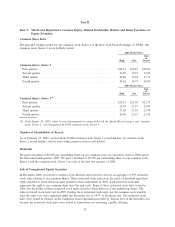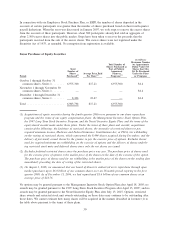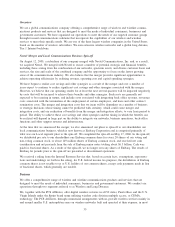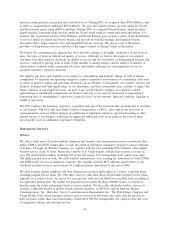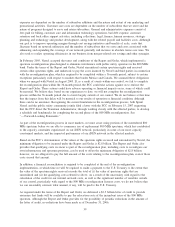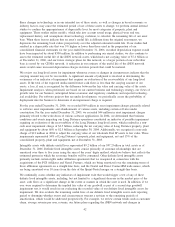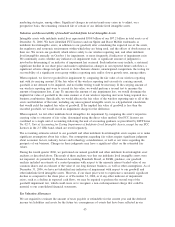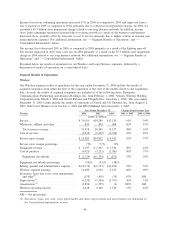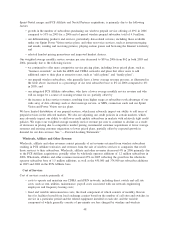Sprint - Nextel 2006 Annual Report Download - page 40
Download and view the complete annual report
Please find page 40 of the 2006 Sprint - Nextel annual report below. You can navigate through the pages in the report by either clicking on the pages listed below, or by using the keyword search tool below to find specific information within the annual report.• expect to substantially complete the integration of a number of other systems, including human
resources, general ledger, sales commissions and billing. We believe that integration of these systems
onto single platforms will create efficiencies in the way we do business, and in the case of our billing
system, will increase functionality for our customer care representatives and produce more reliable
information, which should enhance the customer experience. We have completed various phases of our
systems and processes consolidation plan in the fourth quarter 2006 as discussed in Part II, Item 9A,
“Controls and Procedures.”
In the future, we also plan to utilize QUALCOMM Incorporated’s QChat»technology, which is designed to
provide high performance walkie-talkie services on our CDMA network, and we are designing interfaces to
provide for interoperability of walkie-talkie services on our CDMA and iDEN networks.
We also plan to deploy a next generation broadband wireless network that will be designed to provide
significantly higher data transport speeds using our spectrum holdings in the 2.5 gigahertz, or GHz, band and
technology based on the Worldwide Inter-Operability for Microwave Access, or WiMAX, standard. We are
designing this network to support a wide range of high-speed IP-based wireless services. Our initial plans
contemplate deploying the new network in larger metropolitan areas with a goal of launching the related
service offerings in some of those markets beginning in 2008.
Our Wireless segment generates revenues from the provision of wireless services, the sale of wireless
equipment and the provision of wholesale and other services. The ability of our Wireless segment to generate
service revenues is primarily a function of:
• the number of subscribers that we serve, which in turn is a function of our ability to acquire new and
retain existing subscribers; and
• the revenue generated by each subscriber, which in turn is a function of the types and amount of
services utilized by each subscriber and the rates that we charge for those services.
We believe that wireless carriers increasingly must attract a greater proportion of new customers from the
existing customer bases of competitors rather than from first time purchasers of wireless services. For example,
we are experiencing increased competition in our prepaid and youth markets from new entrants that are
targeting these subscribers. Certain of our competitors continue to increase their focus on customer retention
efforts and have reported improvements in their customer retention rates, which may make it harder for us to
acquire new customers from these competitors. In addition, the higher market penetration of wireless services
in our markets may suggest that customers purchasing wireless services for the first time may, on average,
have a lower credit rating than existing wireless users, which generally results in both a higher churn rate due
to involuntary churn and in higher bad debt expense. This has intensified the competition among wireless
carriers to attract higher quality customers with stronger credit standing, resulting in aggressive pricing
strategies for both voice services and other features that are designed to attract those customers.
We have also experienced declines in the average voice revenue per subscriber due to our offering more
competitive service pricing plans, including lower priced plans, such as “business essentials” and plans that
allow users to add additional units to their plans at attractive rates. We are developing and implementing
service plans that are designed to offset these declines in voice revenue by expanding and enhancing our
value-added array of imaging, high-speed data messaging, entertainment and location-based applications.
Recently, the growth in revenue per subscriber generated by these data services, while significant, has not kept
pace with the decline in voice revenue, resulting in a decline in our overall monthly average revenue per
subscriber.
The ability of our Wireless segment to generate equipment revenues is primarily a function of the number of
new and existing subscribers who purchase handsets and other accessories. The ability of our Wireless segment
to generate wholesale revenues is primarily a function of the number and type of MVNOs that resell our
wireless service and the rates that we charge MVNOs for utilization of our network.
Although many of the costs relating to the operation of our wireless networks are fixed in the short-term, other
costs, such as interconnection fees, fluctuate based on the utilization of the networks. Sales and marketing
38



